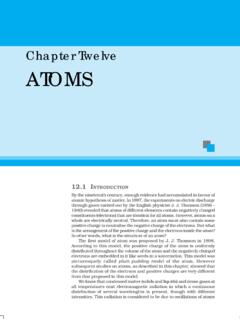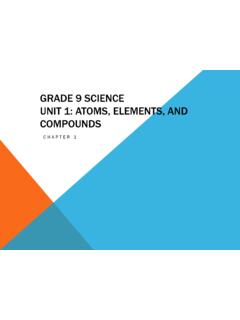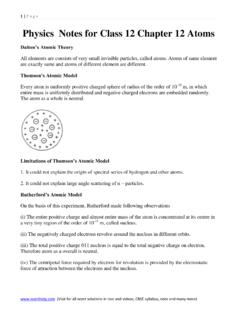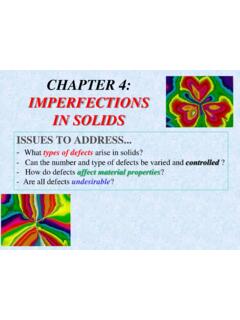Transcription of Chapter 7 Chemical Bonding and Molecular Geometry
1 Chapter 7 Chemical Bonding and MolecularGeometryFigure buckyballs, buckminsterfullerene molecules (C60) contain only carbon atoms. Here they areshown in a ball-and-stick model (left). These molecules have single and double carbon-carbon bonds arranged toform a geometric framework of hexagons and pentagons, similar to the pattern on a soccer ball (center). Thisunconventional Molecular structure is named after architect R. Buckminster Fuller, whose innovative designscombined simple geometric shapes to create large, strong structures such as this weather radar dome near Tucson,Arizona (right). (credit middle: modification of work by Petey21 /Wikimedia Commons; credit right: modification ofwork by Bill Morrow) Chapter Ionic Covalent Lewis Symbols and Formal Charges and Strengths of Ionic and Covalent Molecular Structure and PolarityIntroductionIt has long been known that pure carbon occurs in different forms (allotropes) including graphite and it was not until 1985 that a new form of carbon was recognized: buckminsterfullerene, commonly known as a buckyball.
2 This molecule was named after the architect and inventor R. Buckminster Fuller (1895 1983), whosesignaturearchitecturaldesignwastheg eodesicdome,characterizedbyalatticeshell structuresupportingasphericalsurface. Experimental evidence revealed the formula, C60, and then scientists determined how 60 carbon atomscouldformonesymmetric, thetopicofthischapter whichexplains how individual atoms connect to form more complex 7 Chemical Bonding and Molecular Ionic BondingBy the end of this section, you will be able to: Explain the formation of cations, anions, and ionic compounds Predict the charge of common metallic and nonmetallic elements, and write their electronconfigurationsAsyouhave learned, ionsare atoms ormolecules bearing anelectrical (apositive ion)formswhenaneutralatomlosesoneormoree lectronsfromitsvalenceshell,andananion(a negativeion)formswhenaneutralatom gains one or more electrons in its valence composed of ions are called ionic compounds (or salts), and their constituent ions are held together byionic shed some light on the nature of ionic bonds.
3 Ionic solids exhibit a crystalline structure and tend to berigid and brittle; they also tend to have high melting and boiling points, which suggests that ionic bonds are solids are also poorconductors ofelectricity forthe same reason the strength ofionic bondspreventsions from moving freely in the solid state. Most ionic solids, however, dissolve readily in water. Once dissolved ormelted, ionic compounds are excellent conductors of electricity and heat because the ions can move about atoms and their associated ions have very different physical and Chemical properties. Sodiumatomsformsodium metal, a soft, silvery-white metal that burns vigorously in air and reacts explosively with water. Chlorineatomsform chlorine gas, Cl2, a yellow-green gas that is extremely corrosive to most metals and very poisonous toanimals and plants.
4 The vigorous reaction between the elements sodium and chlorine forms the white, crystallinecompound sodium chloride, common table salt, which contains sodiumcationsand chlorideanions(Figure ).The compound composed of these ions exhibits properties entirely different from the properties of the elementssodium and chlorine. Chlorine is poisonous, but sodium chloride is essential to life; sodium atoms react vigorouslywith water, but sodium chloride simply dissolves in (a) Sodium is a soft metal that must be stored in mineral oil to prevent reaction with air or water. (b)Chlorine is a pale yellow-green gas. (c) When combined, they form white crystals of sodium chloride (table salt).(credit a: modification of work by Jurii /Wikimedia Commons)The Formation of Ionic CompoundsBinary ionic compounds are composed of just two elements: a metal (which forms the cations) and a nonmetal(whichformstheanions).
5 Forexample, NaCl isabinaryionic and lose electrons easily. These elements lie to the left in a period or near the bottom of a group on theperiodic table. Nonmetal atoms have relatively high electron affinities and thus readily gain electrons lost by metal346 Chapter 7 Chemical Bonding and Molecular GeometryThis content is available for free at , thereby filling their valence shells. Nonmetallic elements are found in the upper-right corner of the all substances must be electrically neutral, the total number of positive charges on the cations of an ioniccompound must equal the total number of negative charges on its anions. The formula of an ionic compoundrepresents the simplest ratio of the numbers of ions necessary to give identical numbers of positive and negativecharges.
6 For example, the formula for aluminum oxide, Al2O3, indicates that this ionic compound contains twoaluminum cations, Al3+, for every three oxide anions, O2 [thus, (2 +3) + (3 2) = 0].Itisimportanttonote,however, (NaCl) molecule becausethereisnotasingleionicbond,perse, thesameinalldirections , ,forexample, consists of a regular arrangement of equal numbers of Na+cations and Cl anions (Figure ).Figure atoms in sodium chloride (common table salt) are arranged to (a) maximize opposite chargesinteracting. The smaller spheres represent sodium ions, the larger ones represent chloride ions. In the expanded view(b), the Geometry can be seen more clearly. Note that each ion is bonded to all of the surrounding ions six in +andCl of energy to dissociate one mole of solid NaCl into separate gaseous Na+and Cl ions:NaCl(s) Na+(g) + Cl (g) H= 769kJElectronic Structures of CationsWhen forming a cation, an atom of a main group element tends to lose all of its valence electrons, thus assumingthe electronic structure of the noble gas that precedes it in the periodic table.
7 For groups 1 (the alkali metals) and 2(thealkalineearthmetals),thegroupnumber sareequaltothenumbersofvalenceshellelect ronsand,consequently,to the charges of the cations formed from atoms of these elements when all valence shell electrons are example, calcium is a group 2 element whose neutral atoms have 20 electrons and a ground state electronconfiguration of 1s22s22p63s23p64s2. When a Ca atom loses both of its valence electrons, the result is a cation with18 electrons, a 2+ charge, and an electron configuration of 1s22s22p63s23p6. The Ca2+ion is therefore isoelectronicwith the noble gas groups 12 17, the group numbers exceed the number of valence electrons by 10 (accounting for the possibilityoffulldsubshellsinatomsofelem entsinthefourthandgreaterperiods).Thus,t hechargeofacationformedbytheloss of all valence electrons is equal to the group number minus 10.
8 For example, aluminum (in group 13) forms 3+ions (Al3+). Chapter 7 Chemical Bonding and Molecular Geometry347 Exceptions to the expected behavior involve elements toward the bottom of the groups. In addition to the expectedions Tl3+, Sn4+, Pb4+, and Bi5+, a partial loss of these atoms valence shell electrons can also lead to the formationofTl+,Sn2+,Pb2+,andBi3+ ofthese 1+,2+,and3+cations isascribed totheinert pair effect,which reflects the relatively low energy of the valences-electron pair for atoms of the heavy elements of groups 13,14, (group12)alsoexhibitsanunexpectedbehavio r:itformsadiatomicion,Hg22+(anionformedf romtwomercuryatoms,withanHg-Hgbond),inad ditiontotheexpectedmonatomicionHg2+(form edfromonlyone mercury atom).Transition and inner transition metal elements behave differently than main group elements.
9 Most transition metalcations have 2+ or 3+ charges that result from the loss of their outermostselectron(s) first, sometimes followed ,iron(1s22s22p63s23p63d64s2)formstheion Fe2+(1s22s22p63s23p63d64s2) by the loss of the 4selectronand the ion Fe3+(1s22s22p63s23p63d5)by theloss ofthe 4selectron and one ofthe 3delectrons. Although thedorbitals ofthe transition elements are accordingto the Aufbau principle the last to fill when building up electron configurations, the outermostselectrons are thefirst to be lost when these atoms ionize. When the inner transition metals form ions, they usually have a 3+ charge,resulting from the loss of their outermostselectrons and the Electronic Structures of CationsThereareatleast14elementscategori zedas essentialtraceelements essential because they are required for healthy bodily functions, trace because they are required onlyin small amounts, and elements in spite of the fact that they are really ions.
10 Two of these essential traceelements, chromium and zinc, are required as Cr3+and Zn2+. Write the electron configurations of , write the electron configuration for the neutral atoms:Zn: [Ar]3d104s2Cr: [Ar]3d34s1 Next, remove electrons fromthe highest energy orbital. For the transition metals, electrons are removedfrom thesorbital first and then from thedorbital. For thep-block elements, electrons are removed fromtheporbitals and then fromthesorbital. Zinc is a member of group 12, so it should have a charge of 2+, ,wefindthefollowingelectronconfiguration sof the ions:Zn2+: [Ar]3d10Cr3+: [Ar]3d3 Check Your LearningPotassium and magnesium are required in our diet. Write the electron configurations of the ions expectedfrom these :K+: [Ar], Mg2+: [Ne]348 Chapter 7 Chemical Bonding and Molecular GeometryThis content is available for free at Structures of AnionsMostmonatomicanionsformwhenaneutra lnonmetalatomgainsenoughelectronstocompl etelyfillitsoutersandporbitals, , ,forexample,hastheelectronconfiguration1 s22s22p4,whereastheoxygenanionhastheelec tronconfigurationofthenoblegasneon(Ne), give the oxide ion the charge of 2 (O2 ).















